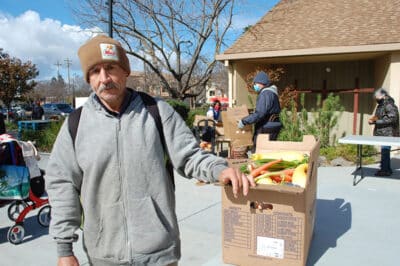Nourishing our communities is at the heart of what food banks do day-in and day-out. The charitable food system, which began as a way to address food insecurity and alleviate food waste, has now evolved into a network of food banks and pantries providing access to nutritious foods, robust nutrition education and additional safety-net resources. As we evolve with how we show up for our communities, the language we use is evolving too.
Why nutrition security is important?
Food security is a common term used in food banking, policy and advocacy, but it’s limited in scope. The focus is on quantity of food, or making sure all household members have access to enough food. Nutrition security considers the quality of food, acknowledging the strong connection between lack of food and diet-related diseases.
Nutrition security is defined as consistent access, availability, and affordability of foods and beverages that promote well-being, prevent disease, and, if needed, treat disease, particularly among racial/ethnic minority populations, lower income populations, and rural and remote populations including Tribal communities and Insular areas.
Il USDA Actions on Nutrition Security report released in March 2022 highlights the strong association between food insecurity and poor nutrition. Individuals who reported being most food insecure were also at higher risk of developing diet-related diseases such as obesity, diabetes and hypertension. This link between poor diet and health is why Second Harvest is focused on providing nutritious foods, making them easily accessible and offering nutrition education to support the long-term health of our neighbors and community.
“The true difference between food security and nutrition security is the difference between living and thriving. While thriving denotes someone existing and breathing in their best selves, living still leaves something to be desired. If we want our neighbors to thrive, not just live, we owe it to them to aim for a future where the foods they have access to promote health in all of its aspects, mind, body, and spirit.”
Rickeya Feggans, Nutrition Services Manager at Feeding America
Expanding our efforts to advance nutrition security
The nutrition security movement recognizes there are many factors that can impact someone’s health, and food is just one of those factors. Making nutritious foods accessible to the community is crucial, but our clients’ ability to take and use this food is impacted by a number of considerations, including cultural preferences, space, time and ability to plan and prepare nutritious meals. This is where food banks’ nutrition teams have the chance to thoughtfully engage within communities to learn more about these barriers.
Second Harvest’s Community Nutrition team aims to work deeper in community to best understand these factors and barriers impacting health while learning from those with lived experiences. We’re helping connect individuals with integrative nutrition education along with culturally inspired recipes, helping one to make informed choices to improve their diet and view their health with a more holistic approach. The team loves to inspire food bank clients on ways to easily prepare and use the foods they receive and provide health and gentle movement tips for optimal physical and mental health.
This type of nutrition education is not a one size fits all approach. Each interaction or class is tailored to meet the needs of the particpants by learning from them and finding the knowledge in the room, ultimately providing a space to celebrate around food and to empower participants with tools they need to continue their health journey. Second Harvest’s Community Nutrition team continues to address nutrition security as an essential part of its work and main goal to improve the health and wellbeing of the communities we serve by providing dignified and inclusive nutrition education and helping foster a positive relationship with food.



Clients from our nutrition classes enjoying easy, no-cook recipes, incorporating both fresh and canned ingredients.
As we continue to build on what we have known for years about food and nutrition insecurity, we stay committed to providing accessibility to wholesome foods, incorporating inclusive nutrition education, and empowering our community members to cook nutritious meals they know and love.
Food banks can continue to foster the growth of resilient communities and together, we can nourish our communities to thrive.



